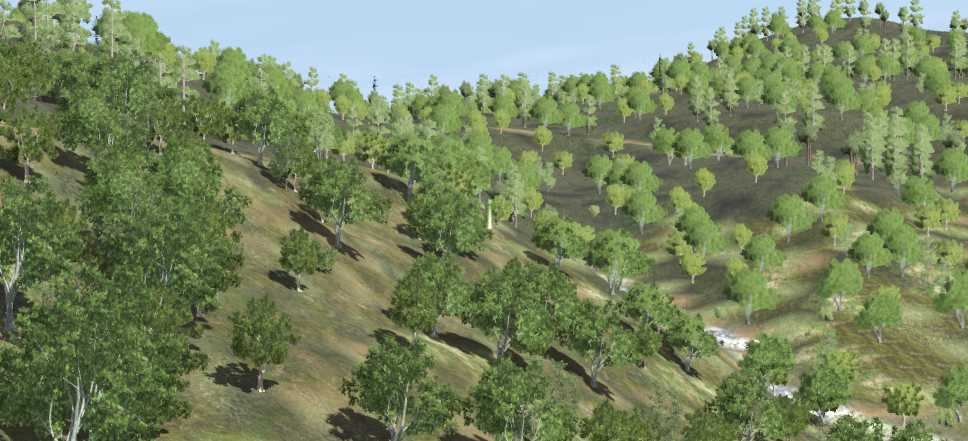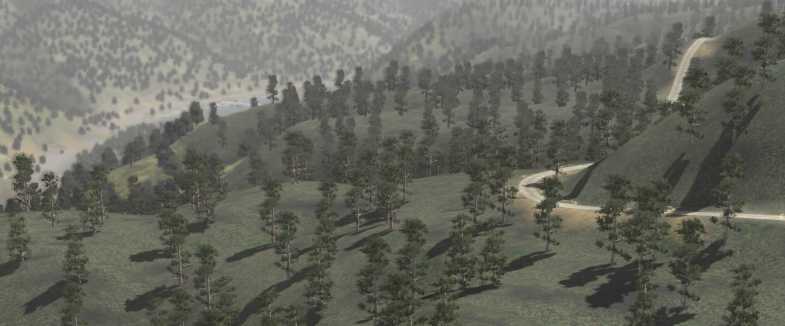Install the app
How to install the app on iOS
Follow along with the video below to see how to install our site as a web app on your home screen.
Note: This feature may not be available in some browsers.
You are using an out of date browser. It may not display this or other websites correctly.
You should upgrade or use an alternative browser.
You should upgrade or use an alternative browser.
Light and Dark Trees - LOD?
- Thread starter boleyd
- Start date
Why are distant trees a different color? LOD should only change resolution.
There are a number of assets where the LOD has been incorrectly implemented, but this is mostly shrub splines, not trees. If you quote the KUID of the affected assets someone might look at them for you.
This is a speedtree asset, so LOD (or whatever the speedtree equivalent is) is managed within the speedtree code. The effect is not fog related, as the change in density is too sharp, and it moves exactly in sync with the view distance. If it is avoidable, there does not appear to be anything changeable within the asset that would affect it. Other speedtree assets might not show the effect, or might not show it to the same extent.<kuid2:523:19723057:2>
Unfortunately, this is a common problem with many of the built-in Speedtrees when viewed at a distance.
At a minimum, I'd expect that more distant LODs should retain the averaged colours of the trees as when shown at LOD0 or LOD1...
The end result at present is an unnatural - and visible - transition for (the same species of) trees at intermediate distances.
At a minimum, I'd expect that more distant LODs should retain the averaged colours of the trees as when shown at LOD0 or LOD1...
The end result at present is an unnatural - and visible - transition for (the same species of) trees at intermediate distances.
ZecMurphy
Community Assistant
Hi Boleyd
Could you please let us know what the 'tree detail' setting is set to within Trainz, and what your 'shadow detail' setting is set to in the Trainz Settings?
This does appear to either be a lower LOD (most likely the 'billboard' LOD, which is a flat plane with a picture of the tree on it), or a change in shadows.
Lower settings of the 'tree detail' setting will cause the LOD on SpeedTree assets to change earlier (This is how the detail is reduced), so if the settings are lower then you may see the lowest LOD appear earlier than may look best.
Lower settings of the 'shadow detail' setting will result in the shadows being removed earlier, which may result in some objects becoming lighter, since there are no longer shadows being applied.
Regards
Could you please let us know what the 'tree detail' setting is set to within Trainz, and what your 'shadow detail' setting is set to in the Trainz Settings?
This does appear to either be a lower LOD (most likely the 'billboard' LOD, which is a flat plane with a picture of the tree on it), or a change in shadows.
Lower settings of the 'tree detail' setting will cause the LOD on SpeedTree assets to change earlier (This is how the detail is reduced), so if the settings are lower then you may see the lowest LOD appear earlier than may look best.
Lower settings of the 'shadow detail' setting will result in the shadows being removed earlier, which may result in some objects becoming lighter, since there are no longer shadows being applied.
Regards
The following is at all settings maximum. Frame Rate = 5fps. For obvious reasons I cannot use these settings and have never really tested their effects. The tress N3V offers do look good. But to reach that conclusion you have to ignore the 5fps. Frankly I would not spend the money for this level of visual quality due to the "two tone" trees at a distance. If you retained the same brightness (if that is the effected component) it might be worth it but I will just use the McQuirel creations and see the consistency I can see from my window a few hundred miles from this scene..


ZecMurphy
Community Assistant
Hi Boleyd
Unfortunately by increasing both at the same time, you haven't given a lot to work with.
As a test, could you try leaving the shadows at your previous setting and then try increasing the tree detail.
Please note, detail sliders are there to provide options to increase or decrease detail in Trainz. If your system is not powerful enough to run Trainz with higher detail settings, then of course it will not look as good when you lower the settings. If it looked as good at either setting, then there would be no advantage for those with more powerful systems, and there would be no reason to have the setting in the first place.
I know it's not what people want to hear, but it is the nature of gaming.
The exact performance will also greatly depend on the route being used; routes that have more detail (or more of a higher detail object) or that use objects that are less efficient will perform worse than routes that are lower detail or use more efficient objects.
Regards
Unfortunately by increasing both at the same time, you haven't given a lot to work with.
As a test, could you try leaving the shadows at your previous setting and then try increasing the tree detail.
Please note, detail sliders are there to provide options to increase or decrease detail in Trainz. If your system is not powerful enough to run Trainz with higher detail settings, then of course it will not look as good when you lower the settings. If it looked as good at either setting, then there would be no advantage for those with more powerful systems, and there would be no reason to have the setting in the first place.
I know it's not what people want to hear, but it is the nature of gaming.
The exact performance will also greatly depend on the route being used; routes that have more detail (or more of a higher detail object) or that use objects that are less efficient will perform worse than routes that are lower detail or use more efficient objects.
Regards

I have "quality" settings all set to midway. Very light fog. Post Process is off due to annoying flickers from the water. Nice try. Trees are mostly McGuirel. With this mid-range setup note the range of lighting on the hillsides, good. Too bad you guys could not help her bring these trees into TRS19. However, in y case, they are the best visual representation of real trees. Those speed-tree things may have advantages but, for me, they do not out-weigh the visual impact in the mountainous areas I like. The McGuirel trees closely match the trees in the Appalachian Mountains of the Northeastern USA. The bright green foliage and white trunks of the SpeedTrees are VERY far from the reality I can see in the forest from my windows. I now have to re-balance the Sun and Ambient lighting to reduce the total black shadows. The water was fun since it ain't blue here. I think limestone in the soil makes it grey/gray.
I am satisfied with this setup. If two-tone trees bothers anyone then try the McGuirel stuff. The structure of the Speedtrees is not bad but someone needs to fix the two-tone and overly bright green foliage. Back to Hinton and the RailYard. Oh, TRS19 crashed when I switched to it while writing the message. I have become used to that so long as it does not force a rebuild on restart.
===========================================
Western Edge of the Appalachian Mountains route-30 in Pennsylvania. The towers are AT&T microwave relays. Note, no bright green trees and no bright white tree trunks. The forest is very dense.
That makes it expensive in TRS19. Google Earth

Last edited:
Similar threads
- Replies
- 43
- Views
- 2K


